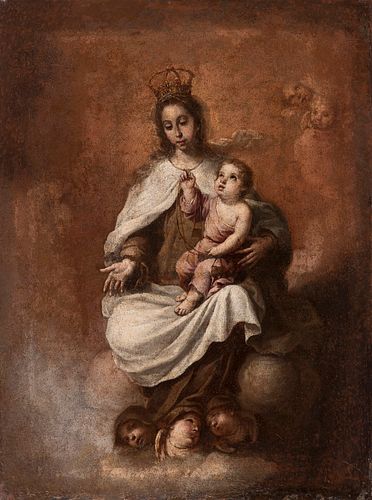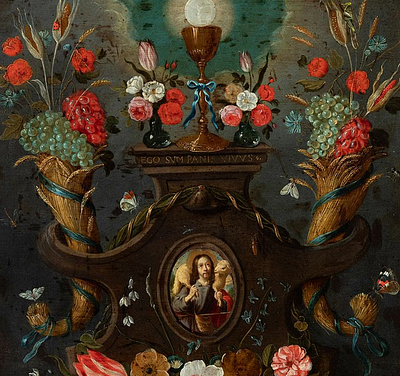Workshop of BARTOLOMÉ ESTABAN MURILLO (Seville, 1617 - Cadiz, 1682). "Virgin of La Merced". Oil on canvas.
Lot 11
About Seller
Setdart Auction House
Carrer Aragó 346
Barcelona
Spain
Setdart Subastas was born in 2004 and is currently the first online art auction in Spain with solidity, prestige and reliability guaranteed by our more than 60,000 users. Setdart has a young, dynamic and enterprising team ready to successfully manage the purchase and sale of art works through custom...Read more
Estimate:
EUR€7,000 - EUR€9,000
$7,291.67 - $9,375
Absentee vs Live bid
Two ways to bid:
- Leave a max absentee bid and the platform will bid on your behalf up to your maximum bid during the live auction.
- Bid live during the auction and your bids will be submitted real-time to the auctioneer.
Bid Increments
| Price | Bid Increment |
|---|---|
| EUR€0 | EUR€10 |
| EUR€200 | EUR€25 |
| EUR€500 | EUR€50 |
| EUR€1,000 | EUR€100 |
| EUR€3,000 | EUR€200 |
| EUR€5,000 | EUR€500 |
| EUR€10,000 | EUR€1,000 |
| EUR€20,000 | EUR€2,000 |
| EUR€50,000 | EUR€5,000 |
About Auction
By Setdart Auction House
Sep 21, 2021
Set Reminder
2021-09-21 10:00:00
2021-09-21 10:00:00
America/New_York
Bidsquare
Bidsquare : 21st September - ARAS JÁUREGUI Private Collection - Old Masters, 19th & 20th Century
https://www.bidsquare.com/auctions/setdart-auction-house/21st-september---aras-j-uregui-private-collection---old-masters-19th-20th-century-7429
Setdart Auction House sofia@setdart.com
Setdart Auction House sofia@setdart.com
- Lot Description
Workshop of BARTOLOMÉ ESTABAN MURILLO (Seville, 1617 - Cadiz, 1682). "Virgin of La Merced". Oil on canvas. Measurements: 56 x 41,5 cm. Sobriety, subtlety and elegance come together in this devotional scene, which was formerly attributed to Murillo, by the expert Don Ramón Aznar. In the centre of the composition, the enthroned Virgin, on the faces of little angels, holds the Child on her lap. It is a maternal and intimate scene, defined by the infant attitude of the Child, who plays with the scapular. None of the characters look at each other, nor do they appeal to the viewer, but seem to concentrate on their own thoughts and destinies. Despite this, however, the warmth of the scenes is emphasised by the neutral, golden, faded background. This characteristic is largely reminiscent of works by Murillo's disciple, Francisco Meneses Osorio, such as the Virgin of the Assumption, which belongs to the Wallage Collection. The Virgin of Mercy is a Marian invocation of the Virgin Mary, whose devotion originated in Catalonia. The Order of Mercy was founded around her, initiated by Saint Peter Nolasco at the beginning of the 13th century. It was the Mercedarian monks who spread her cult throughout Spain, France and Italy from that date onwards. The iconography for the representations of the Virgin of Mercy acquired its definitive form in the 16th century, and consists of the Mercedarian habit with tunic, scapular and cloak, all in white, with the Mercedarian coat of arms on the chest. She usually appears wearing a queen's crown, and also with the sceptre in her right hand. The colouring of this work is soft and gentle, and is in keeping with the spirit of Sevillian painting in the late 17th century, and also with the creative sense of Meneses Osorio and his disciples, in short, all of them followers of the style of the great Bartolomé Esteban Murillo, whose work is strongly reminiscent here. Osorio was born in Seville and is thought to have died there. Very little is known of his life. He was a pupil and imitator of Murillo, and it has been suggested that some of the works attributed to Murillo were painted by Osorio. We know that Murillo considered him his friend, that he was a close acquaintance of Juan Garzón, with whom he worked as secretary and that he was later president of the Seville Academy. While he remained in that city he achieved great reputation and notoriety. This reputation is said to have been discarded after his death because it was considered that some of his copies of Murillo's works were so accurate that he should have signed the master's name. In fact, it was suggested that two of his copies had been accepted as genuine works by Murillo. It is said that he and Murillo worked together in the Capuchin church in Cadiz. His main work was painted for the church of San Martín in Madrid, and depicts the prophet Elijah. There are works by him in the museums of Cadiz and Seville, the latter related to the Order of St. Francis. A work depicting Saint Catherine, which is preserved in Cadiz, is said to have had a special devotion to Saint Philip Neri and was buried in the church dedicated to that saint.
- Shipping Info
-
In-house shipping available. Please inquire at admin@setdart.com.
-
- Buyer's Premium



 EUR
EUR CAD
CAD AUD
AUD GBP
GBP MXN
MXN HKD
HKD CNY
CNY MYR
MYR SEK
SEK SGD
SGD CHF
CHF THB
THB
















